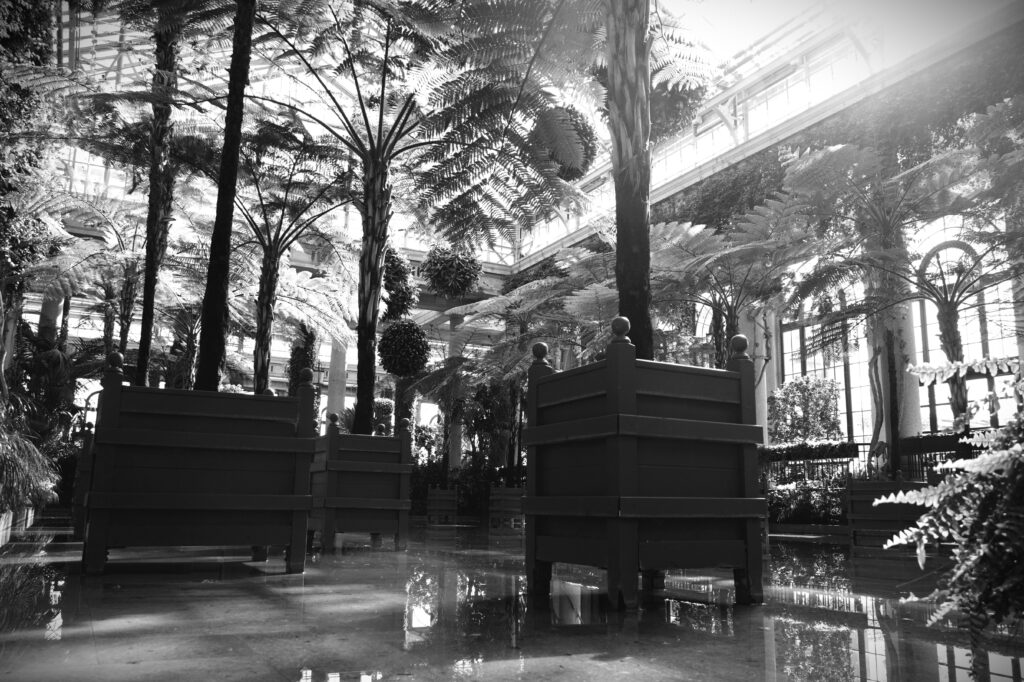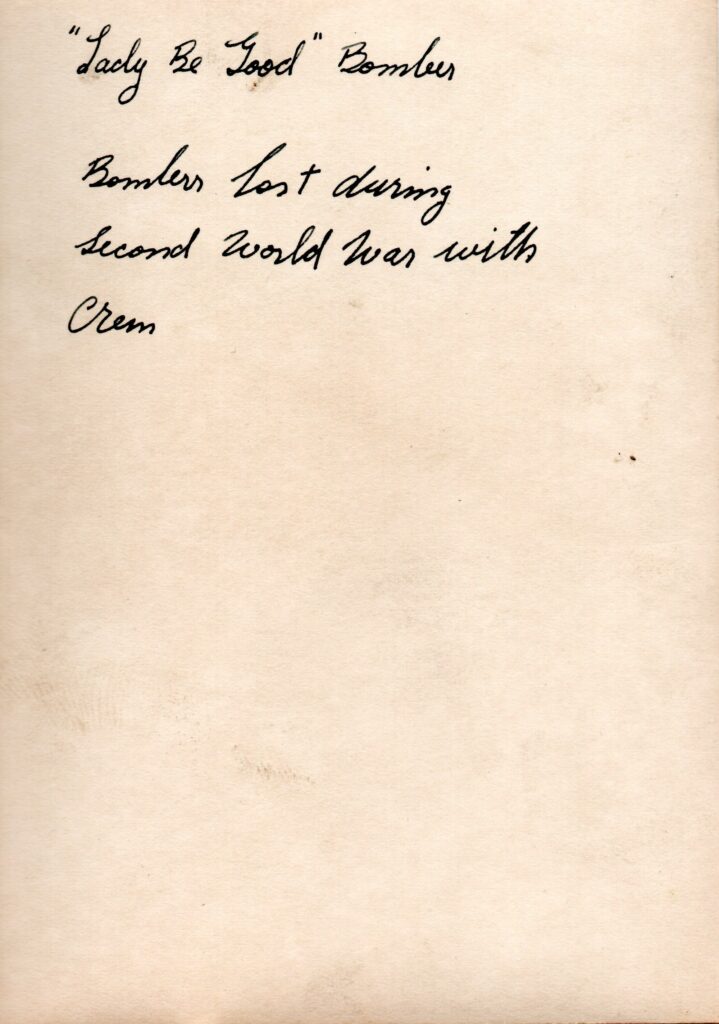
by Edmund R. Schubert
Inside the main greenhouse of the conservatory at Longwood Gardens stood an enormous angel wing begonia. I had no idea the specific variety, but its pint-sized twin lived at home in my kitchen, its flowers pink, miniscule, and ethereal; its leaves oversized and jagged. I’ve always found the leaves far more interesting than the flowers. The specimen growing at Longwood Gardens was five or six times larger than the one I had at home, and I brought my father’s camera to my eye and photographed it.
If my father had been here, he’d have found a way to snip a few cuttings off this angel wing and slip them into his pocket. It struck me as funny to think about that because I’d just come from his funeral. Now it was just me and my father’s camera, exploring his favorite place.
My father routinely brought our family from our home on Long Island down to Longwood Gardens—west and slightly south of Philadelphia—and the end of every visit was always the same: we’d get back to the parking lot and he’d start emptying his pockets, littering the car seat with seeds he’d harvested and with shoots of tender new growth snipped with precise fingernails. I don’t know if he hadn’t been afraid of getting caught or didn’t care, but whenever he brought the family to Longwood, we always came home with souvenirs.
Longwood Gardens is an arboretum created by Pierre du Pont, beginning with a 15-acre property he bought in 1906 to rescue a grove of rare trees from a lumber mill. Originally intending this new property as a place to entertain friends, the site rapidly grew to a 1,000-acre spectacle which duPont opened to the public in 1921.
Nearly one hundred years later, in late 2019, my father was cremated, his memory was celebrated, and on the drive home—I live now in North Carolina—I’d stopped at his favorite of favorites, Longwood Gardens. I had with me my most important inheritance, his Canon 40D camera. This was the next best thing to a pilgrimage.
I moved on from the angel wing in the conservatory’s entrance. It was early December, and in addition to the usual assortment of orchids and bougainvillea, a wave of red and pink poinsettias, fragrant paperwhites, and decorated evergreen trees brought a distinct feel to the place. Noticing a pair of four-foot tall red and gold Christmas bows near the edge of a reflecting pool, I caught myself gesturing toward the bows with the Canon. Gesturing with the camera had unconsciously become my version of pointing out things to my father, as if the camera lens were one of his eyes.
I felt like a five-year-old. Look, Dad. Shiny. Pretty.
The inch of water in the reflecting pool doubled the bows’ mass and number. When I snapped a picture, I aimed low, emphasizing the bows’ reflection. The bows were far more interesting if you didn’t look directly at them.
It also didn’t escape my attention how much more likely I was to notice things like that because I had the camera in my hands.
The du Pont fortune that paid for Longwood Gardens began in factories that manufactured gunpowder, an empire that grew to include the production of a wide variety of toxic chemicals. Before they created the arboretums and museums and libraries that bear their name, the du Ponts were known for lining the banks of rivers with factories spilling tons of waste into once drinkable water. My dad never mentioned that fact when he brought us here; I learned about it years later, from a virtual stranger.
Inside the labyrinth of linked greenhouses, near the back and just before reaching the arboretum’s collection of bonsai trees, I stumbled upon a greenhouse filled with artificial Christmas trees decorated by students at local elementary schools. Tags in front of the cheap plastic trees read: “Mrs. Smith’s third grade class, Lincoln Elementary”; “Mr. Harston’s second grade class, Penn Hills Charter”; “Mrs. Kerry’s sixth grade class”; etc, etc. The trees were adorned with handmade ornaments that had been decorated with crayons and glitter and scented markers and strips of fabric and stickers, each ornament punctured with a holepunch and tied in place with a slender, curly piece of ribbon.
The trees were gorgeous monstrosities, compelling in their garishness. My dad would have hated them. He would have walked right past the whole stupid waste of time.
I wanted him to look at it though. I was going to point his lens at it and make him see it, so I stalked around the space, looking for the ideal angle from which to capture the scene. But it refused to reveal its essence in bits and pieces; you had to step back and appreciate it from a distance. Yet even from a distance, these children’s trees remained unphotographable. It wasn’t enough to step back; you also had to be in and amongst them to truly appreciate their joyful repulsiveness.
I put the lens cap back in place, covering the glass element, and moved on. There was no capturing this moment.
~~~

At my father’s funeral, the pastor made a generic comment about my “loving, patient” father. Then I, the eldest child, came to the front of the room and said, “Let’s be honest, which is the only way Dad knew to do things. He was loving, but he sure as hell wasn’t patient.” I talked about how he was best understood as the ultimate benevolent dictator. He loved us and wanted what was best for us. No one ever doubted that. He also knew what was best for us, so we damn well better do what he told us if we knew what was good for us.
After the memorial service I’d spent hours ruminating on things I wished he’d done; things he might have taught me. He owned a Leica rangefinder camera that he’d picked up in the 1950s when he was in the Army. I have several photographs he took of a B-24 Liberator bomber that got lost over the Mediterranean after a bombing run in Italy and ended up crashing in the Sahara desert in Libya. A decade after that bomber went down, my dad was the first American to set foot in it. Several additional decades later, when I was in high school, he let me use his Leica to take pictures for the school newspaper. He handed the camera to me and told me to be damn sure I didn’t break it. That was the entire conversation. I didn’t hear the story about the B-24 until I overheard him tell it to someone else. At that point I was in my 30s.
After the funeral, my oldest niece ended up with the Leica. It was a valuable antique by then, but what I had wanted was his Canon 40D. To me the 40D represented my father in his later years, his gentler years; the years that began with him learning to change a diaper for the first time shortly after my oldest daughter was born and culminated with him giving up everything to take care of my mother when Alzheimer’s relentlessly and remorselessly consumed her.
~~~
Moving through Longwood’s greenhouses, I frequently found myself wondering how tall a particular plant might grow, or how best to root a cutting from another.
The words, I’ll ask Dad, would walk through my mind, immediately followed by our new reality. Nope, not anymore.
Dad would teach me things, of course. But it was up to me to ask the questions. So much knowledge in his head, but my father was ever the freight train, hurtling down the tracks, not looking left or right: always forward, always head down; always focused on what he believed needed doing. He was one of the hardest working people I ever met.
In the spring of 2018, just over a year and a half before my father died, my mother had a stroke and two major heart attacks. The stroke instantly turned a mild case of Alzheimer’s into a debilitating one. After the stroke and the first heart attack, one night my mom had what the doctor’s called an “episode”—which is a technical term meaning, “we don’t know.” What I do know is that she collapsed in front of me, in the front hallway of their home, strings cut on a marionette, melting into a boneless puddle before my eyes. I caught her and eased her to the floor and watched helplessly as her skin went white, her lips darkening to purple. Someone called 911. I shook her. Called her name. I didn’t know CPR, didn’t know mouth-to-mouth. Just before the ambulance arrived, mom’s heart decided to start beating again. No real reason, it just started back up.
Our family spent a year and half bracing ourselves for my mother’s death, which is one of the reasons why I genuinely don’t know how many times my father went in and out of the hospital with internal bleeding during that same span of time. I’d stay at their house with my mom, who couldn’t be left alone, until Dad came home again. But he always came home again. It never crossed our minds that he wouldn’t. It was what needed doing, and he always did what needed doing.
We paid so much attention to my mom that I don’t think any of us—me, most of all—paid him the attention to him that he needed. And he never asked for it, either. He was the man of the family.
~~~
In the orchid room at Longwood, I was lining up a shot of a cymbidium orchid when a woman stopped her 14-year-old daughter from walking between me and my subject.
“Don’t get in the man’s way,” she chastised. “He’s obviously working on something important.” She gestured toward the Canon in my hands. Dad’s Canon 40D was already ancient by modern digital standards, but it’s big, and big cameras always translate in people’s minds to “professional.”
“Thank you,” I said. “But I’m not working and I’m not in a hurry.”
The woman cocked her head as if I were merely being polite. Her silent, Really? felt like it required a response.
“This was my father’s camera,” I said. “He died last week. Longwood Gardens was one of his favorite places, so I brought his camera here for him one final time.” I glanced at the camera in my hand, then back at the woman. “I have no idea what I’m doing.”
I don’t remember what she looked like. I don’t remember any particular expression crossing her face. I want to imagine her hand went to her heart when she spoke, but I suspect I’m inventing that because it fits the story.
I do, however, know with certainty what she said and the tone with which she said it.
“Thank you for sharing that with me.”
I was taken aback by the depth and genuineness of her emotion. It hadn’t occurred to me to be anything but direct (the only way dad knew how to do things).
~~~
My sister had called me on the phone a few weeks earlier. “He’s gone,” she’d said. “His body is still on life support, but he’s gone. Do you want to come say goodbye before we… you know…?”
Thirty-six hours before that phone call, the doctors had told us they were going to discharge Dad from the hospital and send him home.
“Thanks,” I said to my sister. “But I talked with him right after they discharged him. I told him I’d see him when he got home again. I’d rather that be my final memory.”
~~~
Long before Pierre du Pont purchased the grove of rare trees that became Longwood Gardens, the forest there was known simply as Long Woods. In the 1850s, Long Woods was a stop on the Underground Railroad, supported by local Quakers. And long, long before white or Black folks got to tromping around Long Woods, the Lenni Lenape tribe fished the area’s streams, hunted its forests, and planted its fields.
Back then it didn’t need a name. It simply was.
~~~
I still have my dad’s Canon 40D. It’s sitting on a shelf somewhere, packed securely into a black camera bag. I have so many other cameras now. Too many cameras.
My niece still has Dad’s old Leica, though. Last time I asked her about it, she admitted she didn’t know its whereabouts. Might be at her place, might be in storage at her parents. It’s Schoedinger’s Camera now. We’ll never know if it’s alive or not until we find the box and open it. Until then, it’s both. Or neither.
I’m surprisingly good with that.
~~~
In addition to photography, Edmund R. Schubert is an award-winning writer, editor, and educator. As head editor of InterGalactic Medicine Show (2006-2016), he was nominated four times, winning twice, the Washington Science Fiction Association Small Press Award. In 2024, GTCC presented him with their “Make Amazing Happen” Award for his “inclusive and innovative” work as an adjunct professor. He earned his MFA in Creative Writing from Converse University in 2019 and began pursuing photography seriously in 2020. Recent published short stories came as invited author in the anthologies Lawless Lands and Temporally Deactivated. He is South 85’s Artist-in-Residence for the Winter 2024 & Summer 2025 issues.

